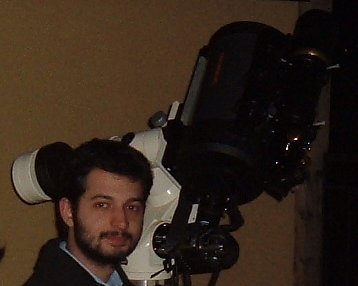 Marco Silva (right) is an amateur astronomer since the 1997 Hale-Bopp comet passage. He is also an amateur scientist. His studies can be found in his web site. When I knew of his interesting measurements of cataclysmic variable stars, I invited him to write about the matter for us here....
Marco Silva (right) is an amateur astronomer since the 1997 Hale-Bopp comet passage. He is also an amateur scientist. His studies can be found in his web site. When I knew of his interesting measurements of cataclysmic variable stars, I invited him to write about the matter for us here.... Cataclysmic Variables
Variable stars are, by definition, all those stars that show a more or less marked variation of brightness over time. The causes of this change may be many. Variable stars can be divided into two classes: "intrinsic" and "extrinsic" ones. Cataclysmic variable stars fall into "extrinsic" variable class, where the source of variability is to be found in the interaction with another object, such as a companion star, or a giant planet, that eclipses the light from the primary.
In the presence of a close binary system of two stars, the gravitational interactions between the primary star (more massive) and its partner (or secondary star) can sometimes be so intense as to allow the exchange of matter between them and the occurrence of thermonuclear explosions on the surface.
The evolutionary history of a cataclysmic variable can be described briefly as follows: in a binary system of normal stars, it may happen that the primary star, at the end of its stay in the main sequence, tends to evolve, getting old, towards the white dwarf stage. During this stage the star's outer layers are dispersed into the surrounding space. The gas spread along the orbital plane generates an effect of "gravitational friction" on the secondary star which, losing angular momentum, approaches the future white dwarf. At this point, because the motion of the two bodies, the excess gas disperses quickly, leaving at the end of the process a "naked" binary system, composed of a white dwarf and a companion star.
In the approach phase, the outer layers of the secondary star, usually a normal star of class G or M, expand and distort due to the intense gravitational field of the white dwarf. Under these conditions, the outer layers of the star can easily reach what astronomers call "Roche lobe", the region of space around a star within which the gas is gravitationally bound to it. If a star expands until the Roche lobe of a nearby star, then compact gas contained in its outer layers can escape the gravitational pull of the star, creating a flow that starts moving towards the compact star through the inner Lagrangian point (L1), the point in space placed along the straight line joining the components of stars, at which the gravitational forces cancel each other. This marks the birth of a cataclysmic variable.
A cataclysmic variable is thus composed of a white dwarf that captures the matter transferred from a normal companion star. The process of accretion is not constant in time but depends, of course, on the amount of matter in the fall, which implies a short fluctuation in brightness. The matter transferred from the companion star (mostly hydrogen) continues to accumulate on the surface of the white dwarf until values of density and temperature are reached such as to trigger an explosion (cataclysm) of the outer layers.
The brightness of the system (now called "Stella Nova") increases by several orders of magnitude for a few hours or days and then fades away and returns to typical values in the following weeks. Once the nova phenomenon, the accretion of matter starts again until conditions for a new explosion are restored: novae may indeed be "recurring", with periods of decades or even centuries. If the captured matter is not regularly expelled it may even increase the mass of the white dwarf up to the Chandrasekhar limit (about 1.4 solar masses), a value beyond which the compact star can no longer support its own weight. The star first implodes, then generates an immense destructive detonation vaporizing the binary system, and becoming visible in our universe in the form of a Type Ia supernova, one of the most violent phenomena that we know.
Cataclysmic variables are also known since the dawn of high-energy astronomy as an important class of X-radiation sources. When compared with other X-radiating binary systems they are, understandably, much less bright, but they are also the most numerous and this allows to study their properties with statistical techniques.
Amateur astronomers can observe this type of stars and give an important contribution to professional scientists. The observation frequency indicated by AAVSO manual is "every clear night" in order to monitor the star condition with a few exposures per night; but if the star is on active/outburst state, nightly time series are required. Cataclysmic variables can be found in quiescence (minimal magnitude condition), stand-still state (middle magnitude state) or in active or outburst state. Every state is important in order to understand the multiple behavior that can be observed between two consecutive outbursts.
A typical cataclysmic system is Z Cam, which shows the light curve displayed in the figure below (from the AAVSO site):
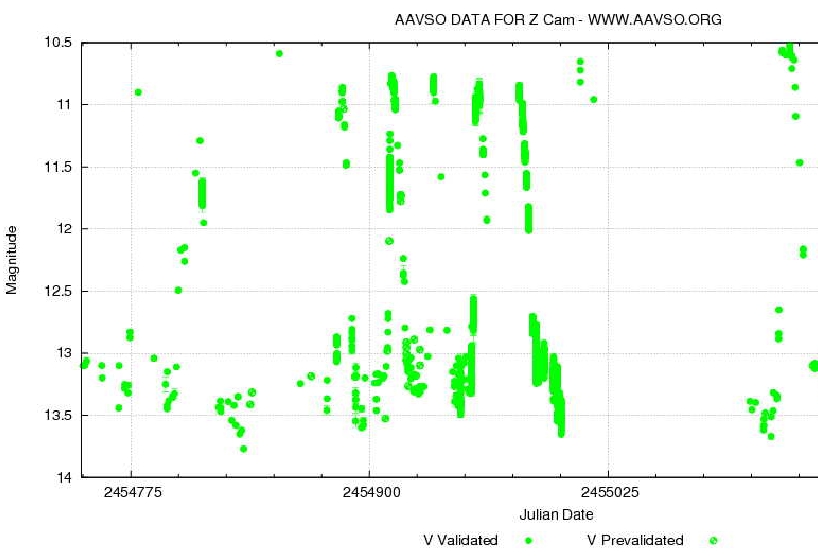
The first cataclysmic variable star I studied, suggested by my friend Stefano Padovan, was TT Ari, which is showing the light curve below (from the AAVSO site):
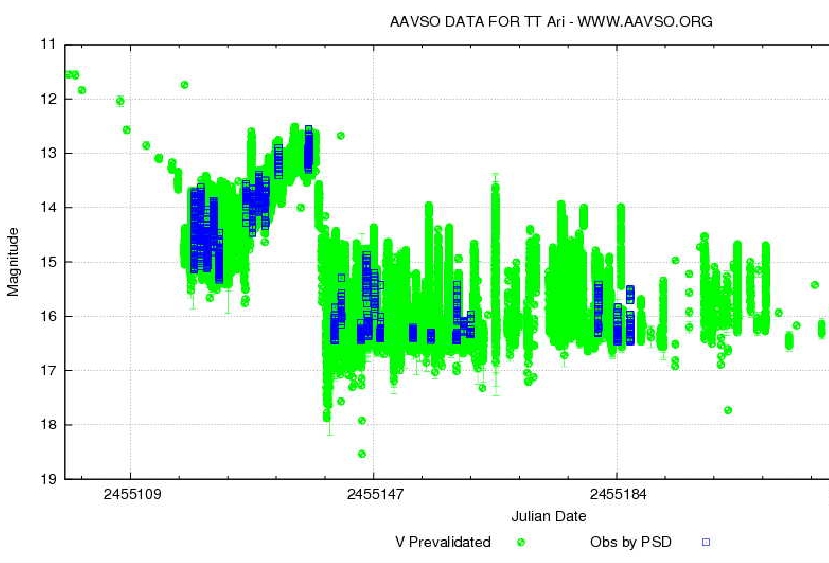
In the figure above the blue dots are the data acquired by Stefano's system in New Mexico - USA (a Takahashi Epsilon 250 with a Sbig ST-10 XME equipped with BVR filters) from October to December 2009, as requested by an AAVSO Alert.
A typical problem for cataclysmic star photometry is to find the correct exposure time in order to avoid the star signal "saturation", considering the wide range of variability in the star magnitude, and maintain a good SNR (Signal-to-Noise ratio; about > 100). This can be superseded by the skill of the astronomer and in these situations Stefano has done a good job.
Our goal in photometry was to participate to the AAVSO program, which is mainly studied to better understand this star's strange behavior because there are many kinds of "variability" in the TT Ari periods like SU Uma, VY Scl and R Coronae Borealis as you can see in the historical light curve below, from the 1970ies up to now:
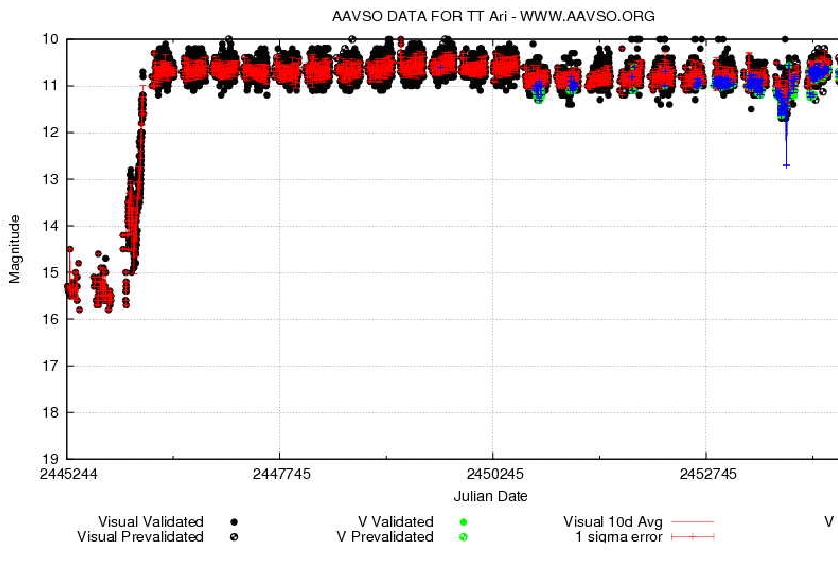
As is evident in the figure above, Tt Ari had a large increase in its magnitude more than thirty years ago, but its variations have been much smaller from then on. Maybe another large change is in the agenda soon ? We will have to keep an eye on it!
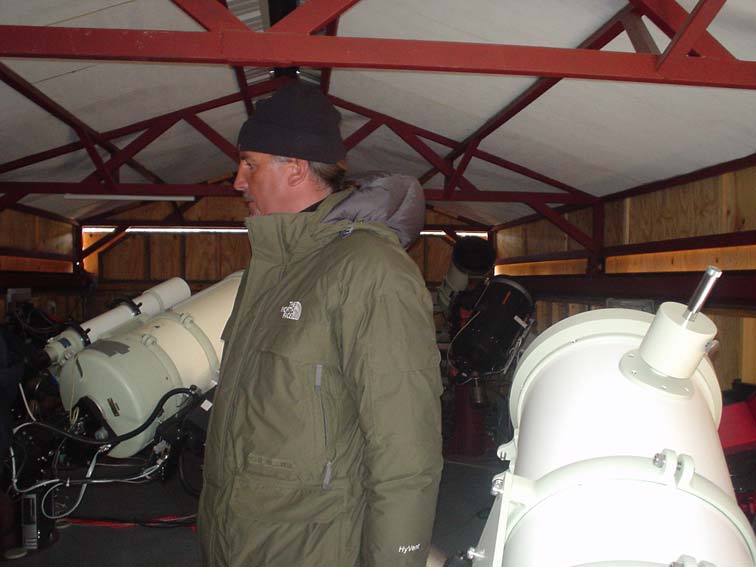
At the end of this post I wish to thank my friend Stefano Padovan, an amateur astronomer since 1976 with a special passion for variables stars, particulary cataclysmic variables and eclypse binary stars, but also for all the beauties in our splendid universe. He is the proud owner of an amazing remote telescope in New Mexico, dedicated mostly to reasearch. His dream is to understand as much as possible of our universe.





Comments